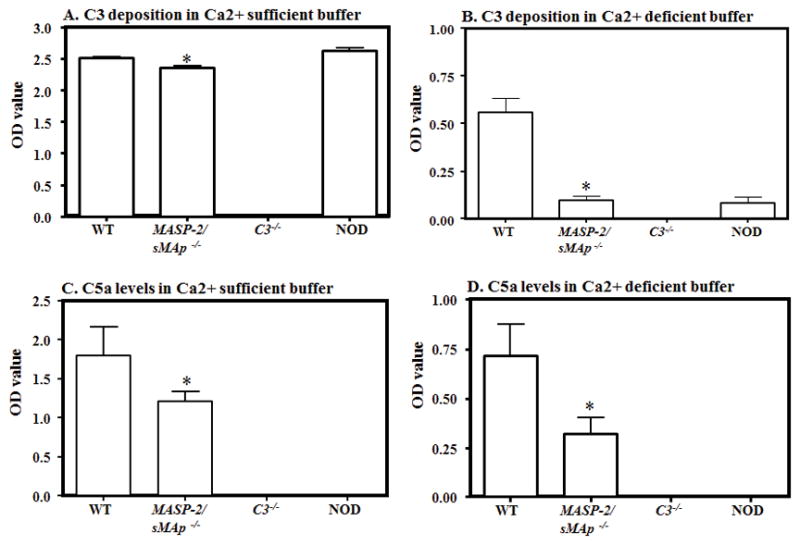FIGURE 6.

Effect of LP protease, MASP-2 deficiency on C3 deposition and C5a levels, at day 10, in WT and MASP-2−/−/sMAp−/− mouse serum with CAIA. All mice were sacrificed after the induction of disease at day 10 and sera were obtained. The ELISA method was used to determine the levels of C3 deposition and C5a generation induced by anti-collagen antibodies as mentioned in Materials and Methods. Sera from WT and MASP-2−/−/sMAp−/− mice were diluted (1:10) in Ca2+ sufficient (GVB+ buffer) (all pathways active) or Ca2+ deficient buffer (Mg2+ EGTA buffer, AP only active and added to the same ELISA plates side by side for an accurate comparison. C3 deposition was determined adherent to the ELISA plate and C5a generation was measured concurrently in the supernatant after the incubation of serum. A. C3 deposition in a Ca2+ sufficient buffer using sera from WT and MASP-2−/−/sMAp−/− mice with disease. B. C3 deposition in a Ca2+ deficient buffer using sera from WT, and MASP-2−/−/sMAp−/− mice with disease. C. C5a generation in a Ca2+ sufficient buffer using sera from WT and MASP-2−/−/sMAp−/− mice with disease. D. C5a generation in a Ca2+ sufficient buffer using sera from WT and MASP-2−/−/sMAp−/− mice with disease. The data were expressed as the optical density (OD) value. Sera from C3−/− and NOD mice (n = 3 each) were used as a negative controls for C3 and C5a respectively for ELISAs. The ELISA data represent the mean ± SEM based on n = 5 for WT and n = 5 for MASP-2−/−/sMAp−/− mice. The black asterisks indicate significant differences (p < 0.05) in comparison with WT mouse serum.
